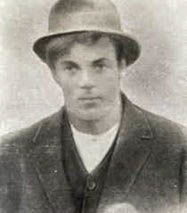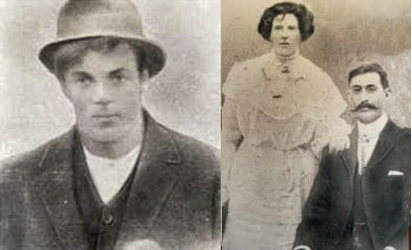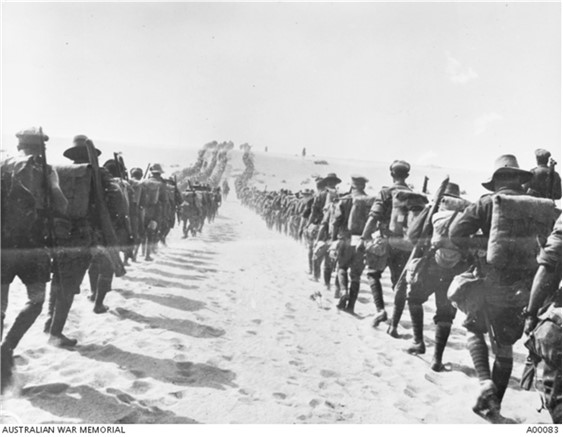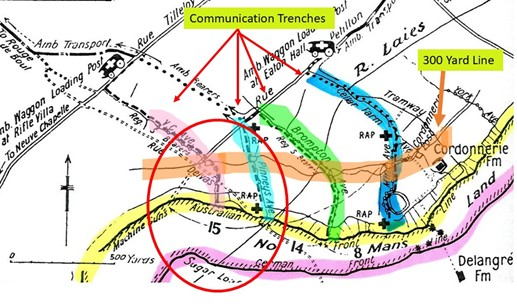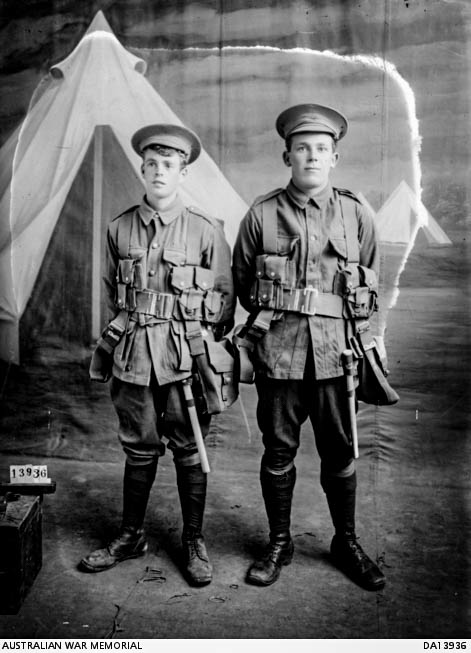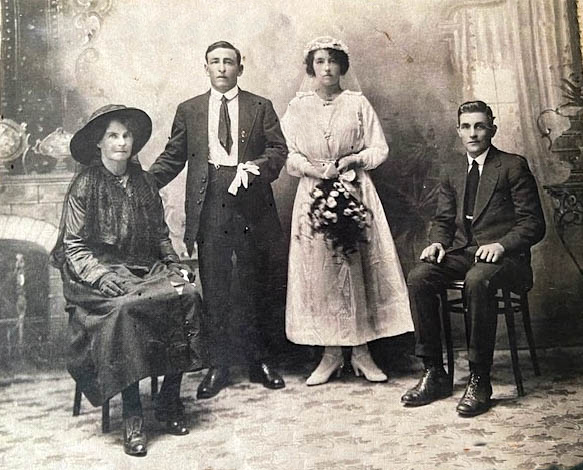Victor William QUINN
Eyes grey, Hair black, Complexion sallow
Victor Quinn – Killed on the 15th, or the 19th?
Can you help us identify Victor?:
Victor was killed in Action at Fromelles. As part of the 58th Battalion he was positioned near where the Germans collected soldiers who were later buried at Pheasant Wood. There is a chance he might be identified, but we need help. We are still searching for suitable family DNA donors.
In 2008 a mass grave was found at Fromelles, a grave the Germans dug for 250 (Australian) bodies they recovered after the battle. As of 2024, DNA matching from relatives has enabled the identification of 180 of these soldiers.
If you know anything of contacts for Victor here in Australia or his relatives from Italy/Switzerland, please contact the Fromelles Association.
See the DNA box at the end of the story for what we do know about his family.
We are very grateful to family member Leanne Digby for sharing her research.
Early Life
Victor William Winsall Basse was born on 3 July, 1894 in Traralgon, Victoria. He was the eleventh of twelve children, five girls and seven boys. The children were born over a period of twenty years in nine towns across Victoria and New South Wales.
Victor’s father Isaiah Constanine (George) Basse was born in Poschiavo, Canton Grisons, Switzerland and migrated to Victoria in the 1870’s. Though born in Switzerland, based on family recollections, George is believed to be Italian, as the area he was born in is close to the Italian border. His mother was Maria Louise Theresa Wade and they were married in 1873. The family was ever on the move as George was a timber cutter and the work followed the building of new rail lines - Echuca, Maldon, Narrandera, Kerang, Cootamundra, Echuca (again), Heathcote, Traralgon, Alberton and Lavers Hill.
Life was also likely difficult for them, which may have contributed to three members of the family being in court in Traralgon for a small theft. After 1895, Victor’s father George left the family and went his own way. Then at some time after 1903, Maria married Patrick Quinn, a timber cutter for the railways, and they remained together until 1939. Victor took on the name Quinn and cites Patrick as his father on his enlistment papers.
Patrick was active in seeking information from the Army after Victor was killed. Victor is likely to have become a timber cutter like his father and brothers - his enlistment papers show him working as a labourer and living in Beech Forest in the Otway area of Victoria.
Off to War
Victor’s older brother George was early to answer the Call to War, enlisting in September 1914 (No. 594). He was assigned to the 5th Light Horse Regiment. He was badly wounded in the shoulder at Gallipoli in July 1915 and, following treatment in England, returned to Australia in April 1916. He also served in WW2 in Cairns from 1940-1943. Victor followed his brother into the AIF, but was rejected in his first attempt due to his eyesight. He reapplied on 15 July 1915 and this time he was accepted and assigned to the 7th Battalion, 12th Reinforcements.
He did his initial military training at the Broadmeadows Camp, outside of Melbourne. After a short period of training, he sailed for Egypt aboard HMAT A40 Ceramic on 23 November 1915.
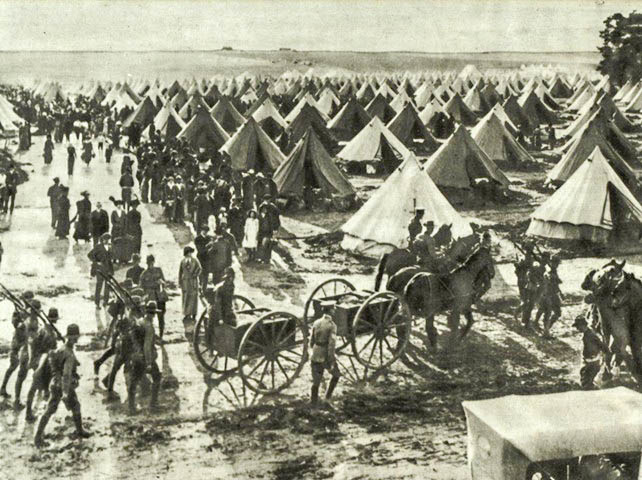
Victor and his fellow reinforcements were then moved to the training camp at Tel-el-Kebir, which was about 110 km northeast of Cairo. The 40,000 men in the camp were comprised of Gallipoli veterans and the thousands of reinforcements arriving regularly from Australia. With the ‘doubling of the AIF’ as it expanded from two infantry divisions to five, major reorganisations were underway. In late February Victor was moved from the 7th to the newly formed 59th Battalion and then in mid-March to the 58th Battalion.
Roughly half of the 58th were Gallipoli veterans from the 6th Battalion and the other half were fresh reinforcements from Australia. Soon after this last move, the 58th had a three-day march across the sands with full packs in the Egyptian heat to the Ferry Post Camp for further training and guarding of the Suez Canal.
By early June the Battalion was at a total strength of over 1000 men. On 13 June they were in Moascar and orders were received to head to the Western Front. They boarded the H7 Transylvania in Alexandria on 17 June and arrived in Marseilles on the 23rd. From there they were immediately entrained for a three-day ride to Steenbecque, 35 km from Fleurbaix.
Victor was headed to the area of Fleurbaix which was known as the “Nursery Sector” – a supposedly relatively quiet area where inexperienced Allied troops could learn the harsh realities of Western Front trench warfare against the Germans, although the quiet times and the training period did not last long.
The Battle of Fromelles
After marching to Fleurbaix and continuing their training, including the use of gas masks, they were into the trenches for the first time on 11 July. In his memoirs, Bill Boyce (3022) of the 58th summed the situation up well:
“What have I let myself in for?”

The battle plan had the 15th Brigade located just to the left of the British Army. The 59th and 60th Battalions were to be the leads for this area of the attack, with the 58th and 57th as the ‘third and fourth’ battalions, in reserve. This was a very difficult position with the ‘Sugar Loaf’ salient, a heavily fortified position with many machine guns, directly across from them. Fire from here could enfilade any troops advancing towards the front lines, giving the Germans a significant advantage.
If the Sugar Loaf could not be taken, the Australian advances would also be subjected to counterattacks from that flank. The 58th Battalion’s role in the main battle was to be carrying ammunition, digging the communication trenches for area gained in No Man’s land and, if needed, direct support for the fighting.
On the morning of 15 July, the 58th were near the front lines, ahead of the 300 yard line (see below) when heavy shelling began, killing a number of soldiers and causing significant damage to the parapet and the communication trenches.
Further, a German raiding party made it into the Australian lines and was able to capture a Lewis Gun from the 58th.
The 15th Brigade and 58th Battalion War diaries state the shelling resulted in:
“Great difficulty in evacuating killed and wounded…”
“Those missing are believed to be covered by debris.”
A and B Companies bore the brunt of the bombardment and between the shelling and the raid, 42 soldiers were killed, 103 were wounded and 5 were missing. An enquiry in the field held on 21 July 1915 confirmed Victor as having been Killed in Action on the 15th. Victor’s identification disc was recovered and sent home, as noted in a letter from his father.
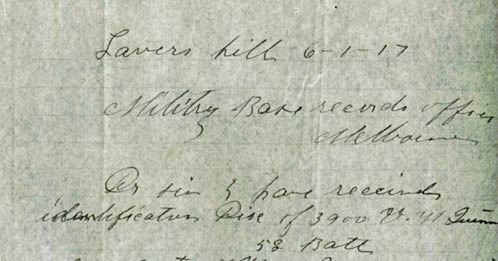
However, even with his ID disc having been recovered, there are NO specifics about him being buried, other than an undated statement with a generalised location about being ‘Buried in the vicinity of Fleurbaix’.
On 19 July, the Zero Hour for the Aussies to advance from their front-line trenches to begin the main attack was to be 5.45 PM, but the Germans knew this was coming and were well-prepared. They opened a massive artillery bombardment on the Australians at 5.15 PM, causing chaos and many casualties. The 59th and 60th went over the parapet at 5.45 PM with immediate and intense fire from rifles and the Sugar Loaf machine guns, just a short distance away. As documented in the messages sent back to HQ just after the attacks began:
“cannot get on the trenches as they are full of the enemy”
“every man who rises is shot down”
With the severity of the German’s defence, the 58th’s A and B Companies were brought forward for support at 9 PM. The 15th Brigade notes on the battle captures the intensity of this part of the attack – “they were enfiladed by machine guns in the Sugar Loaf and melted away.”

At 11.15 PM the rest of the 58th were brought forward to try digging in at 100 yards from the German trench, but no further progress was reported. By 2.52 AM all of the 58th were withdrawn and replaced by the 57th. Of the 1002 men of the 58th that left Egypt, the roll call reflected 27 killed, 167 wounded and 53 missing. The figures for the 15th Brigade were 84 killed, 1163 wounded and 563 missing.
Ultimately, the impact from the battle on the 58th was that 154 soldiers were killed or died from wounds. Of this total, 64 remain missing/unidentified.
Was there a Different Outcome for Victor?
While the Army records for Victor’s death of 15 July seem clear, fellow 58th soldier Private John Troy (ed. not Trow) (4948) reported to the Red Cross just three days after the battle that he saw that Victor and Private Michael Maloney (4157) had been killed during the early advances by the Australians on 19 July.

John Troy would have known Victor as both came from Beech Forest and Victor’s sister Alice had been married to Henry Troy, John’s uncle. Like Victor, Michael Maloney was also documented by the Army as having been killed on 15 July. Red Cross witness statements were often not able to be taken until many months after the battle, so some memories after such an eventful night may not be fully reliable.
However, this report was just three days after the battle by someone who would have known Victor. So, it is very hard to dismiss this as inaccurate, especially as Victor’s body was not recovered after the bombings in the Australian lines on the 15th.
Back Home
The Quinns were notified about Victor’s death and, as above, they even received his ID disc, but there were no details about his death. Both his mother and his father (Patrick) continued to seek further information about their son for years.
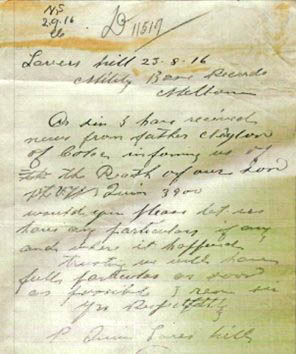

Even after the war, Victor’s mother wrote the Army, still seeking information about his death:
“I hear to (sic) many reports about mistakes being made that I am very uneasy concerning my son Private Victor William Quinn No 3900 who enlisted from Beech Forest Vic in 1915. I have not had any final official report of his death, but one of my other sons R.S. was speaking to one who had just come back and had been in the hospital. He told my son that in the next bed to him lay a Quinn who had lost his memory[,] that this lad Quinn had come from Victoria.”
Victor was awarded the 1914-15 Star Medal, the British War Medal, the Victory Medal, a Memorial Plaque and a Memorial Scroll. He is commemorated at the Villers-Bretonneux Memorial.
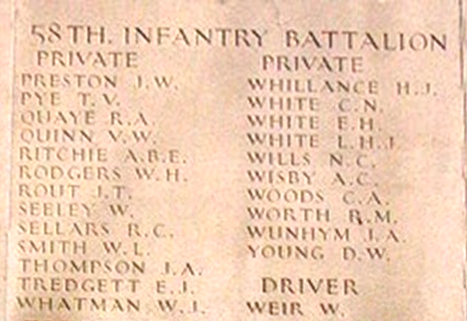
Family Reflection
Leanne Digby writes:
A few years ago I started tracing the Basse side of my mother’s family and discovered the war record for Victor Quinn (Basse). I read the heartbreaking letters to the war office from my great great grandmother Louisa Maria Teresa Quinn who believed her son may still be alive.
I was contacted by the Fromelles Association and discovered the project to identify soldier remains found in France. With the possibility of identifying Victor’s remains in mind I set out to trace the family line to see if there were any direct male line descendants.
Through this journey I have discovered and connected with cousins from the Basse line and we have shared family stories including Victor’s war service. I feel sad for what my great great grandmother experienced when her son did not return home, but proud to have an Anzac in my family line.
I wonder how Victor would feel knowing his death has been the catalyst for uniting the present-day Basse generations some of whom had no idea about the extent of the Basse family.
Could Victor be Found?
With the possibility that Victor was actually killed on the 19th and not the 15th, there still is a chance. After the battle, the Germans collected 250 soldiers who were later buried at Pheasant Wood. As of April 2024, 180 of these soldiers have been able to be identified and given proper recognition from DNA testing from family donors. Victor could be one of those yet unidentified, but we need help. We are still searching for suitable family DNA donors.
If you know anything of Victors contacts here in Australia or his Basse relatives from Italy/Switzerland, please contact the Fromelles Association.
DNA samples are being sought for family connections to
| Soldier | Victor William Winsall or Winsle QUINN (1894-1916) KIA at Fromelles. Birth name is BASSE |
| Parents | Isaiah Constantine ( George) BASSE (1850-1919) b Switzerland died NSW and Maria Louisa Theresa WADE (1856-1939) b Castlemaine, vic died Townsville, Q. Stepfather Patrick Quinn died 1939 Queensland |
| Siblings | Agnes Maria (1875- ) b Echuca, Vic, m Davies/Duffy, daughters Florence and Gwendoline | ||
| Harriet Emily (1876-1960) b Echuca VIC, m Davies | |||
| Isaac Andrew (1877-1953) b Maldon VIC, m Ethel Louise Tyler 1930 | |||
| Amelia Chelistena (1880-1960) b Narrandera, NSW , m Stephen Melfort Donaghue 1900 | |||
| George Thomas Constantine (1883-1950) b Bendigo VIC (254 AIF, 5th Light Horse) | |||
| William T (1885-1885) b Cootamundra NSW | |||
| Luigi (Lewis) Ferdinand George (1885-1962), m Ellen Victoria Burns | |||
| Alice Louise Elizabeth (1886-1964) b Echuca, d Qld, m John Samuel Temby | |||
| Joseph Dominic (1888-1948) Heathcote, m Edith Ellen Costigan | |||
| Amy Arabella (1890 -1948) Alberton Vic, m Richard David Kendall 1904 | |||
| Austin (1895-1895) Traralgon Vic (one day old) |
| Grandparents | |||
| Paternal | Andreu Basse (abt 1820 – ) Poschiavo Switzerland and Emily Soller, Switzerland | ||
| Maternal | Frederick William Wade (1835-1867) Yorkshire and Bridget Maria Clohessy (1836-1904) Dublin IRL |
Seeking DNA Donors

Contacts
(Contact: carla@fromelles.info or geoffrey@fromelles.info).
(Contact: army.uwc@defence.gov.au or phone 1800 019 090).
Donations
If you are able, please contribute to the upkeep of this resource.
(Contact: bill@fromelles.info ).
